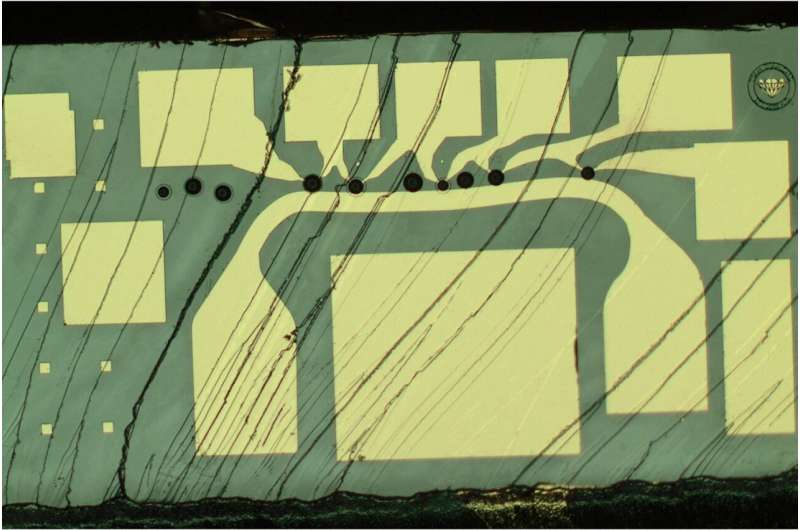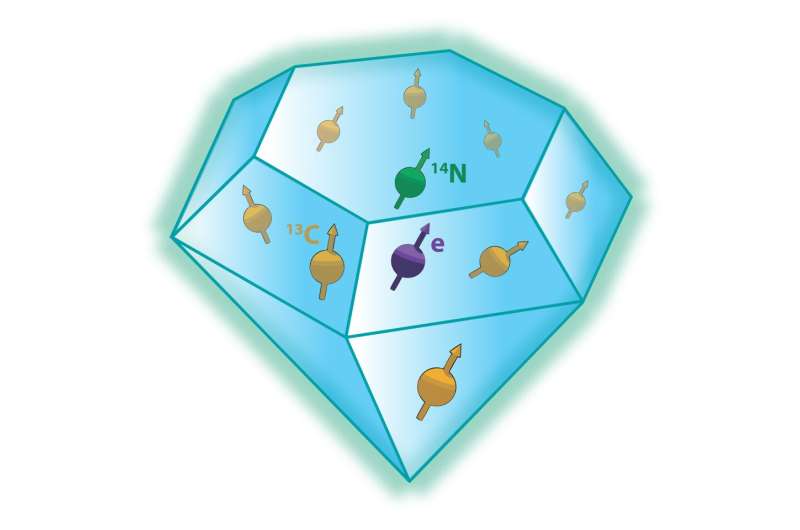A schematic sketch of the 10-qubit register. Credit: Bradley et al.
In years to come, quantum computers and quantum networks might be able to tackle tasks that are inaccessible to traditional computer systems. For instance, they could be used to simulate complex matter or enable fundamentally secure communications.
The elementary building blocks of quantum information systems are known as qubits. For quantum technology to become a tangible reality, researchers will need to identify strategies to control many qubits with very high precision rates.
Spins of individual particles in solids, such as electrons and nuclei have recently shown great promise for the development of quantum networks. While some researchers were able to demonstrate an elementary control of these qubits, so far, no one has reported entangled quantum states containing more than three spins.
In order to reach the computational power necessary to complete complex tasks, quantum registers should be significantly larger than those realized so far. However, controlling individual spins within complex and strongly interacting quantum systems has so far proved to be very challenging.
Recently, a team of researchers at TU Delft and Element Six has successfully demonstrated a fully controllable ten-qubit spin register with a quantum memory up to one minute. Their findings, presented in a paper published in Physical Review X, could pave the way for the development of larger and yet controllable quantum registers, ultimately opening up new exciting possibilities for quantum computing.
"The main objective of our study was to realize a precisely controlled system of a large amount of qubits using the spins of atoms embedded in a diamond," Tim Taminiau, one of the researchers who carried out the study, told Phys.org via email. "These spins are promising quantum bits for quantum computation and quantum networks, but previous results were limited to just a few qubits. The key open challenge is that on the one hand, all the spins in the system must be coupled together to function as a single quantum processor, but on the other hand, this makes it difficult to selectively control them with high precision."
Taminiau and his colleagues successfully developed an entirely new method to control multiple qubits. This technique uses an electron spin qubit to selectively control many individual nuclear spin qubits, while simultaneously decoupling them and thus protecting them from unwanted interactions in the system.
Using their method, the researchers were able to control a considerably larger number of spins compared to previous studies, with remarkably high precision. They applied their technique to a system composed of 10 spins associated to a nitrogen-vacancy (NV) center in diamond. This NV center has an electron spin providing a qubit than can be optically read out (i.e. one can determine its value) and that can be controlled with microwave pulses.
An optical image of a chip similar to the one used in this study. Credit: Bradley et al.
"This electron spin couples to nuclear spins in the environment," Conor Bradley, a Ph.D. student and lead author of the study, explained. "One such nuclear spin is the intrinsic nitrogen nuclear spin of the NV. The additional 8 qubits are carbon-13 nuclear spins surrounding the NV. Naturally about 1.1 percent of the carbon atoms in diamond are carbon-13 and have a spin, i.e. they can be used as a qubit, the other carbon atoms are carbon-12 and carry no spin."
Although the researchers applied their method to a specific 10-qubit system, they believe that it could also be implemented on other systems, including other defect centers in diamond and silicon carbide, quantum dots and donors in silicon. The qubits hosted by these other systems each have their own strengths for completing a variety of complex tasks.
"The main achievement of our study is a 10-spin-qubit quantum system that can store quantum information for very long times up to 75 seconds," Taminiau said. "Although other researchers were able to attain similar results with ions trapped in vacuum, this combination of many qubits, precise control and long-lived quantum memory is unique for chip-based quantum bits."
The system demonstrated by Taminiau and his colleagues could be a key building block for large quantum networks in which multiple NV centers, each providing several qubits, are connected together optically. This particular capability was already outlined and shown by the researchers in a previous study.
"Besides the importance of this study as a demonstration towards larger quantum information systems, this work also provides new insights into the decoherence—the loss of quantum information—for spins in solids," Taminiau said.
The findings gathered by this team of researchers highlight the feasibility of studying how entangled states of multiple spin qubits decohere, as well as how correlations in the noise environment can play a vital role in this process. The method they developed also opens up new possibilities for quantum sensing and atomic-scale imaging of individual spins, where the goal is not to control spins but rather to detect them, in order to gather insight into interesting samples for studies in chemistry, biology and material science.
In their future research, Taminiau and his colleagues plan to demonstrate a technique called quantum error correction. This particular type of error correction could help to overcome all of the inevitable imperfections of existing quantum systems, ultimately enabling the creation of large-scale quantum systems.
"This will require encoding quantum states over many qubits and performing careful measurements to detect and correct errors without disturbing the encoded information," Taminiau added. "This has so far been out of reach for any system, but our results now make it possible to pursue this using spins in diamond."
More information: C. E. Bradley et al. A Ten-Qubit Solid-State Spin Register with Quantum Memory up to One Minute, Physical Review X (2019). DOI: 10.1103/PhysRevX.9.031045
David D. Awschalom et al. Quantum technologies with optically interfaced solid-state spins, Nature Photonics (2018). DOI: 10.1038/s41566-018-0232-2
J. Cramer et al. Repeated quantum error correction on a continuously encoded qubit by real-time feedback, Nature Communications (2016). DOI: 10.1038/ncomms11526
G. Waldherr et al. Quantum error correction in a solid-state hybrid spin register, Nature (2014). DOI: 10.1038/nature12919
B. Hensen et al. Loophole-free Bell inequality violation using electron spins separated by 1.3 kilometres, Nature (2015). DOI: 10.1038/nature15759
Journal information: Physical Review X , Nature Photonics , Nature Communications , Nature
© 2019 Science X Network

























